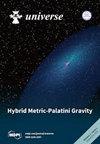Comparing Analytic and Numerical Studies of Tensor Perturbations in Loop Quantum Cosmology
IF 2.5
4区 物理与天体物理
Q2 ASTRONOMY & ASTROPHYSICS
引用次数: 0
Abstract
We investigate the implications of different quantization approaches in Loop Quantum Cosmology for the primordial power spectrum of tensor modes. Specifically, we consider the hybrid and dressed metric approaches to derive the effective mass that governs the evolution of the tensor modes. Our study comprehensively examines the two resulting effective masses and how to estimate them in order to obtain approximated analytic solutions to the tensor perturbation equations. Since Loop Quantum Cosmology incorporates preinflationary effects in the dynamics of the perturbations, we do not have at our disposal a standard choice of privileged vacuum, like the Bunch–Davies state in quasi-de Sitter inflation. We then select the vacuum state by a recently proposed criterion which removes unwanted oscillations in the power spectrum and guarantees an asymptotic diagonalization of the Hamiltonian in the ultraviolet. This vacuum is usually called the NO-AHD (from the initials of Non-Oscillating with Asymptotic Hamiltonian Diagonalization) vacuum. Consequently, we compute the power spectrum by using our analytic approximations and by introducing a suitable numerical procedure, adopting in both cases an NO-AHD vacuum. With this information, we compare the different spectra obtained from the hybrid and the dressed metric approaches, as well as from the analytic and numerical procedures. In particular, this proves the remarkable accuracy of our approximations.环路量子宇宙学中张量扰动的分析研究与数值研究的比较
我们研究了环路量子宇宙学中不同量子化方法对张量模式原始功率谱的影响。具体来说,我们考虑了混合公因子和着色公因子方法,以推导出支配张量模式演化的有效质量。我们的研究全面考察了由此得出的两种有效质量,以及如何估算它们,以获得张量扰动方程的近似解析解。由于环路量子宇宙学在扰动动力学中加入了预膨胀效应,我们无法像准德西特膨胀中的邦奇-戴维斯态那样选择标准的特权真空。于是,我们通过最近提出的一种标准来选择真空状态,这种标准可以消除功率谱中不必要的振荡,并保证哈密顿在紫外的渐近对角化。这种真空通常被称为 NO-AHD(源自 "非振荡与渐近哈密顿对角化 "的首字母)真空。因此,我们在两种情况下都采用 NO-AHD 真空,通过使用我们的分析近似和引入合适的数值程序来计算功率谱。有了这些信息,我们就可以比较从混合方法和着色度量方法,以及从分析程序和数值程序得到的不同频谱。这尤其证明了我们的近似方法的显著准确性。
本文章由计算机程序翻译,如有差异,请以英文原文为准。
求助全文
约1分钟内获得全文
求助全文
来源期刊

Universe
Physics and Astronomy-General Physics and Astronomy
CiteScore
4.30
自引率
17.20%
发文量
562
审稿时长
24.38 days
期刊介绍:
Universe (ISSN 2218-1997) is an international peer-reviewed open access journal focused on fundamental principles in physics. It publishes reviews, research papers, communications, conference reports and short notes. Our aim is to encourage scientists to publish their research results in as much detail as possible. There is no restriction on the length of the papers.
 求助内容:
求助内容: 应助结果提醒方式:
应助结果提醒方式:


